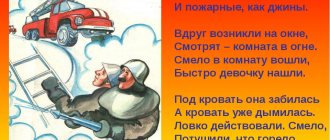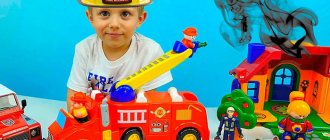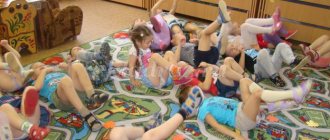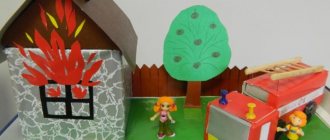Fire safety rules for children
Every year, children under fourteen years of age are killed or seriously injured in fires and fires. The main reason can be called the dishonesty of parents, as well as the lack of knowledge and skills to behave in case of fire. To prevent fire safety, it is necessary to conduct lessons, conversations, and lectures.
It is recommended to consolidate the result with the help of games that help update the information received. Cartoons developed with the support of the Fire Service will help explain fire safety rules to young children (“Fire in the forest”, “Fire in the apartment”, “Rules of behavior for children in case of fire”).
Fire safety rules will be explained during life safety lessons, as well as during class hours on this topic. The use of poems by S. Marshak “Very, very important rules!”, “Song of Matches”, A. Usachev “Fire”, E. Gladkova “If there is a fire in the house” and others will help in this.
Basic fire safety rules for children
- You cannot play with matches, lighters, or match-candles;
- You cannot set fire to dry leaves, dry grass, trees, or poplar fluff;
- You cannot play with fireworks, sparklers, or firecrackers without adult supervision;
- You cannot use gasoline, kerosene and other flammable materials for gaming purposes;
- Do not throw bottles of deodorants, perfumes, air fresheners, etc. into a fire or set fire to them. This may result in an explosion and immediate fire;
- You cannot make a fire or play with an open fire indoors;
- You cannot make a fire in wooden sheds, dilapidated buildings, basements and attics;
- if there is a need for light, it is better to use a flashlight than matches;
Introduction
Fire safety is one of the components of ensuring the national security of the country. A high level of fire safety is an integral component of the high level of socio-economic development of the Russian Federation. Fires cause significant material damage in all sectors of the national economy, leading to injuries and deaths.
In the Russian Federation, more than 130 thousand fires are recorded annually, as a result of which more than 8 thousand people die, the total losses amount to more than 100 billion rubles. The main causes and objects of fires are presented in the figure below.
The most important and obvious fire safety problem to be resolved, along with increasing the efficiency of the actions of fire departments of various types, is also increasing the effectiveness of preventive fire prevention measures and measures taken by citizens and owners to protect property from fire. Correct and timely work in this direction should have an important socio-economic effect in the form of voluntary and comprehensive compliance with fire safety requirements both personally by citizens and by enterprises, institutions and organizations within the framework of official or public activities.
Achieving this global goal is possible only if a high level of training is provided to the country's population in fire safety measures , which, in accordance with Article 1 of the Federal Law of December 21, 1994 No. 69-FZ “On Fire Safety” [1] refers to actions to ensure fire safety, including compliance with fire safety requirements. At the same time, fire safety requirements are special conditions of a social and (or) technical nature established in order to ensure fire safety by the legislation of the Russian Federation, regulatory documents or an authorized state body [1].
A special role in this process is given to managers and persons responsible for ensuring fire safety of organizations, who not only formulate the organization’s policy in the field of fire safety, develop and implement fire safety measures for a specific enterprise, but also have the right to independently train the rest of the employees of this enterprise in measures fire safety as part of fire safety instructions.
This course is intended for managers and persons responsible for ensuring fire safety in institutions (offices).
Rules for handling fire at home
For children, the main rule is not to play with fire without adult supervision. Thus, using and playing with electrical appliances (TV, microwave, computer), turning on a gas stove, lighting candles, playing with light bulbs and garlands are excluded.
Older children can be taught to use a stove and household appliances, but emphasize that if there is no great need for their use, it is better to wait for their parents. A mandatory requirement will be to disconnect all equipment from the power supply after use.
There is no need to turn your child against fire, but you should be as honest as possible about the consequences of fires.
Children are great inventors, thousands of ideas swarm in their heads, and if you do not warn in advance about the results of such dangerous pranks, it will be too late.
Parents must themselves protect their child from danger.
First of all, it is necessary to store all household chemicals out of the reach of children, all of them have a high degree of flammability. Also, children should not have free access to matches, lighters, candles, and electrical wires must be hidden under baseboards.
To test children's knowledge about fire safety rules, you need to conduct small tests or periodically ask them questions. For example:
- what to do if a fire starts? (call the rescue service 112/01, give your name and address);
- How to put out a fire that has just flared up? (thick blanket, wet blanket, fire extinguisher);
- How should you behave during a fire? (don’t panic, don’t hide, call for help).
Children should be told that smoke can be more dangerous than fire itself. And in order not to suffocate during a fire, you need to wet a rag or gauze and breathe through it. It is also necessary to go down to the floor, because the smoke concentration is lower there.
Rules for handling fire in the forest
In most cases, the cause of forest fires is the carelessness and carelessness of people.
- You cannot make a fire in places with dry grass, under tree crowns, or in peat bogs. The place for the fire must be carefully selected, cleared of flammable material, and the fire itself must be lit in a specially dug earthen hole.
- It is not allowed to leave and leave the fire unextinguished or smoldering. It can be filled with water or covered with sand.
- You should not make a fire in dry and windy weather.
- Do not leave paper, plastic utensils or glass items at the resting place. The latter are very dangerous because the sun's rays are focused on the glass, which can result in a forest fire.
- Spontaneously combustible materials should not be left in the forest.
- You cannot use pyrotechnics in the forest.
Preventive measures
The priority fire prevention measures that are carried out at the facility are:
- The use of non-flammable detergents in places where parts or finished products are degreased and cleaned.
- Collection of information on fire hazard parameters of various substances and materials used in the technological process.
- Involvement of automatic fire safety systems.
- Regular testing of the functionality of fire automatic systems.
- Insulation of fire hazardous technological equipment. If necessary, it can be taken out to open areas of the territory.
- The use of fire barriers and quick-acting valves that will prevent the rapid spread of fire throughout the premises and communications.
- A ban on the use of flammable materials during repair work on evacuation routes.
- Use of special smoke protection and other systems in the most fire-hazardous areas.
The effectiveness of fighting fires is ensured only at those enterprises where organizational and propaganda work is well done. Also, exemplary enterprises have and operate a VPD (voluntary fire brigade) and a PTK (fire-technical commission).
According to statistical information, in enterprises more than half of all fires occur due to human negligence or gross violation of existing fire safety rules by employees. The most common causes of fire today include:
- Smoking in places that are not intended for this.
- Electrical household appliances that are not turned off.
- The use of torches or blowtorches to heat parts, pipes and other structures.
To completely eliminate the reasons listed above, it is necessary to introduce the most stringent fire safety regime, and employees are constantly taught the basic rules of fire safety.
Rules for children's behavior in case of fire
If there are no adults near the child during a fire, he will have to make his own decisions and act confidently. To do this, parents or teachers must teach him the chain of actions in case of fire.
- Call 01/112 and report your location and emergency situation.
- Ask your neighbors for help and tell them about the fire.
- Do not hide in hard-to-reach places; rescuers simply will not be able to come to the rescue or find the victim.
- Do not use the elevator during a fire. Go down stairs only.
- Follow all instructions from firefighters and rescuers who arrived at the scene.
Lesson: “Save yourself!”
Topic: “Actions aimed at ensuring the personal safety of a person who finds himself in an extreme situation - a fire”
Visually for children Fire safety rules
There are fire extinguishers on the stage of the assembly hall (in the office). A screen for a projector or a large-diagonal TV, a telephone, machines of light creeping smoke, as well as a small stand with material evidence of fires. There is a videographer in the room who films the most interesting moments during the lesson.
The presenter comes on stage and, making sure that all the students are in their places, addresses the children present.
Leading:
Hello, dear guys! Today your guest is the thematic program “KNOW AND BE ABLE”. Our meeting is called “SAVE YOURSELF!” Many of you will ask me: “Why is it called that?” Because, unfortunately, in our hometown of Omsk, people die in fires, and it also happens that your peers, the same beautiful girls and the same cute boys, also die. People die in fires for many reasons, but many of them die because they do not know how to behave when they find themselves in a situation where a fire has occurred. They either suffocate in the smoke, burn in the fire, or suffer very serious injuries called burns. Many die in burn centers. Therefore, our meeting with you today is dedicated to the actions that we must take if we find ourselves in a fire situation, and the meeting is called “SAVE YOURSELF!”
But before we begin our meeting, I would like to prepare you a little for it. You all know that in our city there is a river station, and near the river station there is the old Siberia Hotel. We arrive at this hotel, where on each floor there is a strict attendant (the presenter portrays a strict “auntie”), who at night is responsible for the safety of the people living in the hotel. We arrive at this hotel and ask this strict “auntie”: “Dear auntie, imagine that a corner on your floor is on fire. How did it happen? There is a plastic trash can in the corner on each floor. The man, who did not comply with fire safety rules, was walking around the floor, smoking and throwing an unextinguished cigarette into a plastic trash can that contained paper and cardboard. After some time, the cardboard and paper caught fire. The floor on the floor is parquet and wood. The floor is on fire, the wood trim on the walls is on fire. We ask auntie: “Dear auntie, what will you do?” She thinks for a while, and then says: “If my floor is on fire in the corner, I’ll call the fire department.”
We tell her: “You’re doing the right thing, auntie! If you discover a fire on your floor, you should immediately call the fire department. What phone number will you call the fire department?” She thinks again and answers: “I’ll call the fire department by phone “01 (112,101).”
- Exactly “01”?
- Yes!!! “02” is the police, and “01 (112,101)” is the fire department.
- What will you do next?
- Like what! I will put out the burning corner.
- What will you use to simmer?
- How, with what? (The presenter approaches the fire extinguisher). Here with the help of a fire extinguisher.
We ask the strict auntie: “How will you put it into action?”
The presenter portrays the attendant on duty who does not know how to use a fire extinguisher, as she tries to turn the handle...
- This... this... this pen.
- What, are you going to break your handle?
- I won’t break it off, but I’ll turn it around.
- And then?
- Then I hit the floor.
- For what?
- To make money.
Guys, don't hit him on the floor.
It will work anyway if you know how to do it and be able to do it. This incident makes many people smile, but on the other hand, this incident causes sadness. Just think about it: ignorance and inability to do so can lead to great trouble, a catastrophe. In order not to be like such “aunties”, we will now begin our meeting and try to discover a lot of new things for ourselves and learn a lot. The presenter turns on the projector and begins commenting on the video material.
— You guys see on the TV screen the fire department dispatcher, who is receiving a phone call from injured people who call “01 (112, 101)” and ask for help.
After the dispatcher receives a call from the victims, he gives the alarm to the fire guard, which guards the area for 24 hours. According to the standards, fire fighters must change into special clothing within 45 seconds, it is called “boevka”, get into the car and drive to their destination, to the people who called “01 (112, 101)” and asked for help.
Let's calculate how long you will wait for help from firefighters: 45 seconds are given to get ready, 5-10 minutes are given to travel. But you wait longer than 6 minutes for help, because while you called “01 (112, 101)”, while the dispatcher called the fire guard, all this time you are in a burning room. Only 11-15 minutes after calling the fire brigade, the fighters will be under your windows, but you have not yet been saved, and if you are on the 8th floor, they will not remove you from there in a second, this also takes time. Let's add another 4 minutes to 11 minutes. We got 15 minutes. Remember this time, because next we will try to find out and learn what we should do, how to behave in these 15 minutes while we are waiting for the firefighters. Now we will analyze two fires and try to understand what could have caused them.
There is a fragment of a fire on the screen.
You see, guys, how our Omsk Academic Drama Theater burned. What caused the fire? Look at this old faulty electrical wire. The electrical wiring is very simple: inside there are two copper or aluminum conductors. Due to old age and dilapidation, the insulating material cracks, crumbles, copper or aluminum conductors are exposed, and a short circuit occurs, a flash occurs, from this flash the insulating material remaining on the electrical wire lights up. This happened in the drama theater. There were old electrical wires on the roof, people did not pay attention to it, they waved their hands. The building is very old, in the dome, which, as you see, is burning, there was a lot of flammable material: wooden beams, boards, logs - and from the burning of the insulating material on the electrical wires, these wooden structures began to burn. Fortunately, no one was injured in the drama theater thanks to the quick and skillful actions of firefighters.
And now you see how a watchman’s trailer burned at a construction site in the Sovetsky district. It was March 20, 1995. March is the month of early spring, that night it was very cold, about 20 degrees below zero. A watchman at a construction site was cold and decided to warm up a little. He entered his trailer, turned on the electric heater (the presenter shows physical evidence - a burnt electric heater). I placed it on the table by the window. There were curtains hanging on the windows, and above the curtains there was a shelf where there were containers with paint, solvent and other flammable materials. When the watchman, having warmed up, went outside (to check if everything was okay at the construction site), opening and closing the doors, a draft was created. The curtains swayed and touched the hot coil of the electric heater. Having flared up, the fire spread to the shelf where containers with paint and solvent stood. In a matter of minutes, the inside of the trailer was engulfed in flames.
Guys! Having remembered what causes fires, let us proceed to the main topic of our meeting today: we will try to find out and learn what we should do, what actions to take if we find ourselves in a fire situation.
The presenter calls the guys from the audience and works with them, like an artist works with tablet dolls.
- I need a good, brave boy or girl!
A boy comes up on stage, the presenter introduces himself to him, and asks the guys in the audience to greet the program participant with friendly applause.
Let's imagine that you, Sasha, were late for school today. You go into school and look... the corridors are all empty, the kids are in class - studying. Sasha goes up to the 4th floor, where his class is studying. He stops near the office door. It seems like my classmates should study in this office,” he thinks. But, putting his ear to the door, he realizes that the office is empty, there are no children there. And suddenly thick smoke starts coming out of the doors, the classroom is on fire!
The presenter picks up a smoke machine and uses it to fill the stage with smoke.
What are you going to do, Sasha?
As a rule, the child gets lost and asks the presenter to put out the fire or run away from school completely. The presenter turns to the audience with a request to help Sasha. All together the guys come to the conclusion that the first thing they need to do is call the fire department.
The presenter takes the phone and helps Sasha call the fire department, explaining the procedure for calling:
- What's burning.
- Where it lights up (address).
- Who reports (full name)
The presenter rewards the first participant in the program for calling the fire department and saving his home school.
The presenter calls the next participant in the program. Let's call him Ivan.
Let's imagine, Ivan, that you are sitting in class during a lesson. You raise your hand and ask permission to leave the classroom for a minute. You leave the classroom on the 4th floor, and suddenly... Sasha runs up to you and says that the office on the 4th floor of the school is on fire, and runs off to call the fire department. Sasha ran away, and you, Ivan, remained standing in front of the burning classroom door. What will you do?
As a rule, the child cannot explain his actions correctly. The presenter’s task is to make the boy understand that no one except them knows about the fire. Therefore, it is necessary to warn the guys by giving a pre-arranged signal - three long, almost continuous calls. Three bells mean there is a fire in the school. The presenter rewards Ivan.
Now the presenter calls a boy and a girl onto the stage, let’s call them Nikita and Dasha.
Let’s imagine, Nikita, that you and your guys went down to the 1st floor and suddenly, right in front of the door that leads to the street, you stop, remembering that Dasha remained on the 4th floor that was burning. You go up to the 4th floor, find Dasha, take her in your arms (the presenter approaches the girl, takes her in his arms and hands her to the boy), and tries to get down from the burning floor. You rush to one, then to another staircase - but there is already fire everywhere. It turns out that you are cut off by fire. Nikita, how will you save Dasha?
The presenter must help correctly determine Nikita’s actions, since incorrect actions can lead to troubles associated with burns, etc.:
- Do not break windows in a burning corridor.
- Find a safe room where nothing is on fire.
- Close the door in the safe room.
- Identify yourself by shouting or in some other way.
- Use clothing to caulk all cracks and holes in the door.
- Stay near the window, without hiding.
The presenter analyzes all actions in a playful way.
The presenter awards Nikita and Dasha. Then he invites all meeting participants to watch the most interesting moments of the meeting recorded on a video camera, remembering that the meeting was called “SAVE YOURSELF!”







